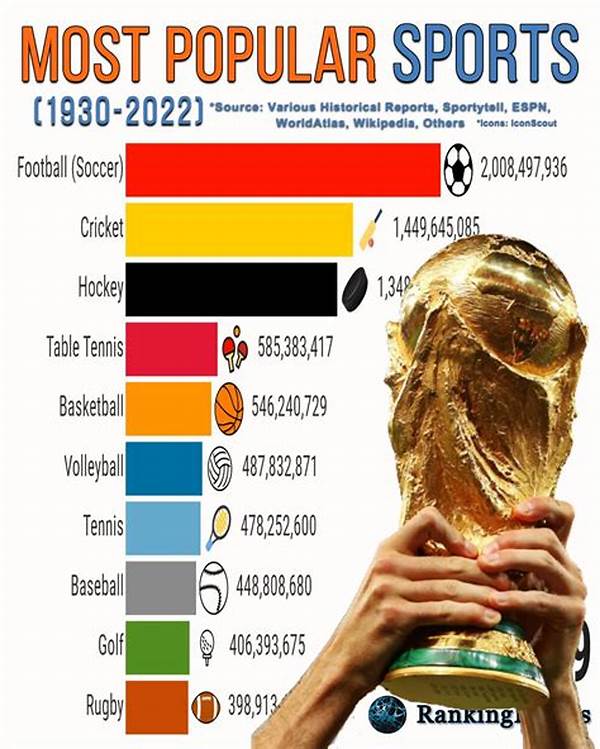How Soccer Became The Most Popular Sport Globally

How Soccer Became the Most Popular Sport Globally
Soccer, or football as it is known in most parts of the world, is undeniably the king of sports. An unassuming yet captivating game that has captured the hearts of millions and continues to grow in popularity every year. But how did this sport, which only requires a ball and a patch of land, transcend cultural and geographical boundaries to become a global phenomenon? It’s an intriguing tale of simplicity, accessibility, cultural significance, and unyielding passion.
Read More : Bbc Sports Football Presents The Latest News On The 2025 World Cup
The beauty of soccer lies in its simplicity. Unlike sports that require expensive equipment or specialized venues, soccer invites everyone to play. This accessibility has been a crucial factor in its global ascent. Even in the remotest villages of Africa, the bustling streets of Brazil, or the crowded neighborhoods of India, a makeshift ball can get a game started. This universality is key to how soccer became the most popular sport globally. It is the sport of the people, for the people, and by the people. The only thing you truly need is the love for the game.
Soccer also thrives on and feeds into cultural identity. In countries such as England, Brazil, and Argentina, soccer is more than just a sport; it’s a way of life. It encompasses a rich tapestry of history, tradition, and shared community experience. Nations come alive during international tournaments, and the sport serves as a powerful tool to unite disparate groups, inspire patriotism, and foster community spirit. These emotional ties contribute to the strength and breadth of its reach.
The role of marketing and media cannot be underestimated in explaining how soccer became the most popular sport globally. Sports channels broadcast games into homes worldwide, turning players like Cristiano Ronaldo and Lionel Messi into household names. Their matches become stories of legends, their life stories interwoven with the dreams of countless people. It’s storytelling at its finest, and it draws spectators in, weaving them into the grand narrative of the sport.
Furthermore, soccer’s global governing bodies, like FIFA and UEFA, have mastered strategic marketing, ensuring that tournaments such as the World Cup and UEFA Champions League are seen by billions. These events are not just competitions; they’re grand spectacles where the best of the best compete, offering moments of pure drama, nail-biting tension, and sublime skill.
The Cultural Impact of Soccer
The cultural implications of soccer’s rise to prominence are both profound and multifaceted. The sport provides a platform for countries to showcase their best talent and present a united front to the world. It’s also a catalyst for economic growth, inspiring the development of new infrastructure and driving tourism during international events. Communities rally around their teams, creating a shared social fabric that celebrates diversity while cherishing common goals.
—
Structure Analysis of How Soccer Became the Most Popular Sport Globally
The journey of how soccer became the most popular sport globally can be broken down into various layers that illustrate its widespread appeal. At the core, it’s about love for the game, but the narratives woven through its history, strategy in its promotion, and the emotional ties it fosters all contribute to its preeminence in the sports world.
The core aspect that makes soccer so globally adored is its accessibility. Imagine the countless games that unfold daily on sprawling fields, narrow alleys, and community parks—where children emulate their idols, attempting ambitious dribbles, mindful passes, and breathtaking goals. This ease of play forms the bedrock of soccer’s global dominance.
Influences Beyond the Pitch
Beyond the game itself, soccer is deeply ingrained in cultural, economic, and sociopolitical structures. Countries measure prowess by their footballing achievements. The sport is infused with stories of hope, struggle, and triumph. The figures of soccer are more than mere athletes; they are protagonists in compelling stories that inspire generations.
Soccer’s embrace of media coverage has also elevated its status. The advent of television and internet streaming allowed the sport to penetrate homes worldwide. From live broadcasts to engaging content on social media, soccer keeps fans connected to every twist and turn of their favorite matches.
The Role of Major Soccer Tournaments
Major tournaments like the FIFA World Cup and UEFA Champions League have helped cement soccer’s status as the world’s favorite sport. These events are more than just competitions; they are grand celebrations of sport and culture. The anticipation, the fanfare, and the drama keep viewers on the edge of their seats, leading to unforgettable moments that etch themselves into the fabric of athletic history.
Read More : The Latest Complete F1 Race Schedule Updates Only On Sky Sports
In summary, how soccer became the most popular sport globally is a narrative deeply rooted in its accessibility, cultural impact, and relentless media strategy. Soccer unifies nations, stirs emotions, and serves as a platform for greatness. Its magic lies in its universal call to the human spirit—the profound joy of playing, watching, and living the beautiful game.
—
Key Elements in Soccer’s Global Popularity
- Accessibility: Played anywhere with minimal equipment
- Cultural attachment: Deeply rooted in many countries’ traditions
- Media presence: Extensive coverage and promotion
- Iconic tournaments: Events that capture worldwide attention
- Celebrity players: Global personalities inspiring the masses
- Social cohesion: Bringing together diverse communities
- Economical benefits: Boosting local economies through tourism and infrastructure
The Global Phenomenon of Soccer
As we dive into the fascinating world of how soccer became the most popular sport globally, we notice it’s not just a game. It’s a phenomenon that encompasses far more than 90 minutes on a field. The sprawling narratives that arise from its matches captivate hearts and ignite imaginations around the world.
Soccer as an Agent of Change
Soccer’s influence stretches beyond mere entertainment. It serves as a developmental bridge across countries, sparking economic opportunities, encouraging participation in sports, and bringing real development through sports diplomacy. Soccer academies nurture talent, and social projects promote education and inclusion, being a catalyst for positive change.
The game’s universal appeal fosters global unity and can often be a channel for humanitarian efforts. High-profile matches raise awareness and funding for various causes, capitalizing on the sport’s reach to effect positive change. Soccer is more than goals and saves; it’s a powerful ally in the journey toward societal improvement.
Recognizing how soccer became the most popular sport globally means appreciating its multi-dimensional success. From emotional histories to tangible futures, soccer’s journey is as dynamic as the sport itself and mirrors the diversity of those who cherish its vibrant spirit.
—
Illustrations of Soccer’s Global Popularity
- Street soccer games in bustling global metropolises
- The electric atmosphere of a packed stadium during a World Cup
- Soccer legends inspiring young talents in grassroots programs
- Iconic moments replayed across global television networks
- An international fan sharing a universal cheer
- Local economies booming from a successful soccer event
Soccer continues to mesmerize billions around the globe. Its unyielding allure transcends boundaries, weaving into the heart of societies, and becoming an inextricable element of human culture. The game emerges as a beacon of hope, a spectacle of triumph, and a testament to the unfathomable capacity of sports to unite disparate cultures under one common love. Soccer is not just popular—it’s a movement, a tradition, a passion that shows no signs of slowing down but only continues to gain momentum in the beautifully intricate world we inhabit.



